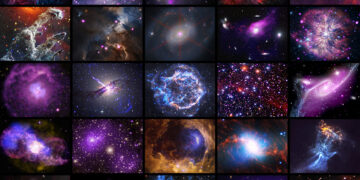Every so often, astronomers spot a stellar explosion that defies expectations—supernovas that shine up to 100 times brighter than they should. These extraordinary events, known as “superluminous supernovas,” have puzzled scientists for years. Now, a new study has shed light on a groundbreaking hypothesis: these supernovas are powered by a “supercharged cocoon of energy” that can release an immense amount of radiation. Let’s dive into what makes these cosmic explosions so special, the science behind them, and what they reveal about the universe.
Understanding Superluminous Supernovas
These powerful stellar explosions are among the brightest events in the universe, shining 10 to 100 times more intensely than typical supernovas. They are believed to originate from the deaths of massive stars, often over 40 times the size of our Sun, which collapse into a neutron star or black hole. This extreme density at the star’s core sets the stage for an extraordinary release of energy that far exceeds what we observe in ordinary stellar explosions.
The rarity of these events has made understanding their exact causes challenging. The most widely accepted theory involves a rapidly rotating disk of material around the neutron star or black hole, generating intense magnetic fields that funnel gas and energy outward in powerful jets. These jets drive the explosion, but the precise mechanics remained unclear until now.
The Supercharged Cocoon of Energy Hypothesis
A new hypothesis proposes that the brightness of superluminous supernovas is driven by a supercharged cocoon of energy enveloping the dying star. According to a recent study, when the star collapses, the jets emerging from the neutron star or black hole create a cavity within the star. This cavity expands, forming a cocoon that absorbs and reprocesses energy, emitting a tremendous amount of radiation that makes the supernova shine far brighter than usual.
Computer simulations and mathematical models have been used to track how these jets interact with the dying star. The researchers found that as the jet forms, it carves out a cavity, and the edges of this cavity, or cocoon, become the critical source of radiation. The cocoon expands, picking up material along its boundaries, and this interaction is what generates the brightness observed for several days. Eventually, the jet breaks through, leading to the complete destruction of the star and a fading of the light.
The cocoon’s formation and the subsequent release of energy provide a powerful explanation that aligns with observational data. For example, the radiation emitted by the cocoon can sustain the peak brightness of the supernova for days or even weeks before the explosion loses its energy, matching what astronomers see when observing these rare events. This model also suggests that if the cocoon were to break apart prematurely, it could lead to different light curves, offering a potential explanation for the variability observed in superluminous supernovas.
Implications and Future Observations
This new model of the supercharged cocoon not only provides a compelling explanation for supernovas but also opens up new avenues for studying these powerful cosmic events. If future observations can detect increased X-ray brightness or identify fast-moving shells of material detaching from the star, it would provide strong evidence supporting the cocoon hypothesis. Such observations could help scientists refine their models and better understand the life cycles of massive stars and the extreme conditions near neutron stars and black holes.
Moreover, this discovery has broader implications for our understanding of the universe. Superluminous supernovas are not just spectacular light shows; they are also laboratories for studying extreme physics. They can reveal the behavior of matter under the most intense conditions imaginable, where gravity, radiation, and magnetic fields interact in complex ways. Understanding these explosions could lead to insights into the processes that govern stellar evolution, the formation of neutron stars and black holes, and the nature of matter under extreme pressure.
Future observations, especially using advanced telescopes like the James Webb Space Telescope, will be crucial in validating the cocoon hypothesis. By observing these events in multiple wavelengths, including X-rays, researchers hope to catch the telltale signs of cocoon formation and the jets breaking through the star’s outer layers. These insights will not only confirm or refine the current model but also provide a deeper understanding of the most energetic explosions in the universe.
Unraveling the Mystery of Superluminous Supernovas
This model helps explain why some supernovas shine so brightly, connecting theoretical predictions with observed phenomena. As we continue to explore these incredible cosmic events, we are not just learning about the stars themselves but also unlocking new mysteries about the universe’s most extreme environments.
Superluminous supernovas remind us of the dynamic and powerful forces at play in the cosmos. Each explosion serves as a beacon of knowledge, pushing the boundaries of what we understand about stellar death and rebirth. As new technologies and observations allow us to peer deeper into these superluminous wonders, we are set to uncover even more secrets about how the universe works on its most energetic stage.
Stay tuned as the story of these supercharged stellar explosions unfolds. The journey into understanding the universe’s brightest supernovas is just beginning, and each discovery brings us closer to unveiling the cosmic mechanisms that power the brightest lights in the sky.
Reference:
Sutherland, R. S., & Wheeler, J. C. (2024). “Superluminous Supernovas and the Supercharged Cocoon Hypothesis.” arXiv preprint



















